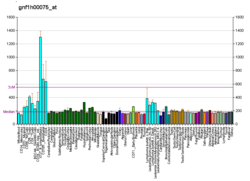FARSB
Phenylalanyl-tRNA synthetase beta chain is an enzyme that in humans is encoded by the FARSB gene.[5][6]
This gene encodes a highly conserved enzyme that belongs to the aminoacyl-tRNA synthetase class IIc subfamily. This enzyme comprises the regulatory beta subunits that form a tetramer with two catalytic alpha subunits. In the presence of ATP, this tetramer is responsible for attaching L-phenylalanine to the terminal adenosine of the appropriate tRNA. A pseudogene located on chromosome 10 has been identified.[6]
References
- 1 2 3 GRCh38: Ensembl release 89: ENSG00000116120 - Ensembl, May 2017
- 1 2 3 GRCm38: Ensembl release 89: ENSMUSG00000026245 - Ensembl, May 2017
- ↑ "Human PubMed Reference:".
- ↑ "Mouse PubMed Reference:".
- ↑ Rodova M, Ankilova V, Safro MG (Apr 1999). "Human phenylalanyl-tRNA synthetase: cloning, characterization of the deduced amino acid sequences in terms of the structural domains and coordinately regulated expression of the alpha and beta subunits in chronic myeloid leukemia cells". Biochem Biophys Res Commun. 255 (3): 765–73. doi:10.1006/bbrc.1999.0141. PMID 10049785.
- 1 2 "Entrez Gene: FARSB phenylalanyl-tRNA synthetase, beta subunit".
Further reading
- Archambault de Vencay J, Thomes JC, Julien R (1978). "Phenylalanyl-tRNA synthetase of the human placenta. Evidence for different enzymatic forms in equilibrium". FEBS Lett. 89 (1): 98–102. doi:10.1016/0014-5793(78)80531-6. PMID 658405.
- Nazarenko IA, Peterson ET, Zakharova OD, et al. (1992). "Recognition nucleotides for human phenylalanyl-tRNA synthetase". Nucleic Acids Res. 20 (3): 475–8. doi:10.1093/nar/20.3.475. PMC 310410. PMID 1741281.
- Sen S, Zhou H, Ripmaster T, et al. (1997). "Expression of a gene encoding a tRNA synthetase-like protein is enhanced in tumorigenic human myeloid leukemia cells and is cell cycle stage- and differentiation-dependent". Proc. Natl. Acad. Sci. U.S.A. 94 (12): 6164–9. doi:10.1073/pnas.94.12.6164. PMC 21020. PMID 9177188.
- Zhou X, Richon VM, Ngo L, et al. (1999). "Cloning of the cDNA encoding phenylalanyl tRNA synthetase regulatory alpha-subunit-like protein whose expression is down-regulated during differentiation". Gene. 233 (1–2): 13–9. doi:10.1016/S0378-1119(99)00170-5. PMID 10375616.
- Zhang QH, Ye M, Wu XY, et al. (2001). "Cloning and functional analysis of cDNAs with open reading frames for 300 previously undefined genes expressed in CD34+ hematopoietic stem/progenitor cells". Genome Res. 10 (10): 1546–60. doi:10.1101/gr.140200. PMC 310934. PMID 11042152.
- Moor N, Linshiz G, Safro M (2002). "Cloning and expression of human phenylalanyl-tRNA synthetase in Escherichia coli: comparative study of purified recombinant enzymes". Protein Expr. Purif. 24 (2): 260–7. doi:10.1006/prep.2001.1560. PMID 11858721.
- Strausberg RL, Feingold EA, Grouse LH, et al. (2003). "Generation and initial analysis of more than 15,000 full-length human and mouse cDNA sequences". Proc. Natl. Acad. Sci. U.S.A. 99 (26): 16899–903. doi:10.1073/pnas.242603899. PMC 139241. PMID 12477932.
- Moor N, Lavrik O, Favre A, Safro M (2003). "Prokaryotic and eukaryotic tetrameric phenylalanyl-tRNA synthetases display conservation of the binding mode of the tRNA(Phe) CCA end". Biochemistry. 42 (36): 10697–708. doi:10.1021/bi034732q. PMID 12962494.
- Ota T, Suzuki Y, Nishikawa T, et al. (2004). "Complete sequencing and characterization of 21,243 full-length human cDNAs". Nat. Genet. 36 (1): 40–5. doi:10.1038/ng1285. PMID 14702039.
- Yu XY, Finn J, Hill JM, et al. (2004). "A series of spirocyclic analogues as potent inhibitors of bacterial phenylalanyl-tRNA synthetases". Bioorg. Med. Chem. Lett. 14 (5): 1339–42. doi:10.1016/j.bmcl.2003.11.081. PMID 14980694.
- Vasil'eva IA, Bogachev VS, Favre A, et al. (2005). "Role of low-molecular-weight substrates in functional binding of the tRNAPhe acceptor end by phenylalanyl-tRNA synthetase". Biochemistry Mosc. 69 (2): 143–53. doi:10.1023/B:BIRY.0000018944.53390.44. PMID 15000680.
- Gerhard DS, Wagner L, Feingold EA, et al. (2004). "The status, quality, and expansion of the NIH full-length cDNA project: the Mammalian Gene Collection (MGC)". Genome Res. 14 (10B): 2121–7. doi:10.1101/gr.2596504. PMC 528928. PMID 15489334.
- Andersen JS, Lam YW, Leung AK, et al. (2005). "Nucleolar proteome dynamics". Nature. 433 (7021): 77–83. doi:10.1038/nature03207. PMID 15635413.
External links
- FARSB human gene location in the UCSC Genome Browser.
- FARSB human gene details in the UCSC Genome Browser.
This article is issued from
Wikipedia.
The text is licensed under Creative Commons - Attribution - Sharealike.
Additional terms may apply for the media files.




